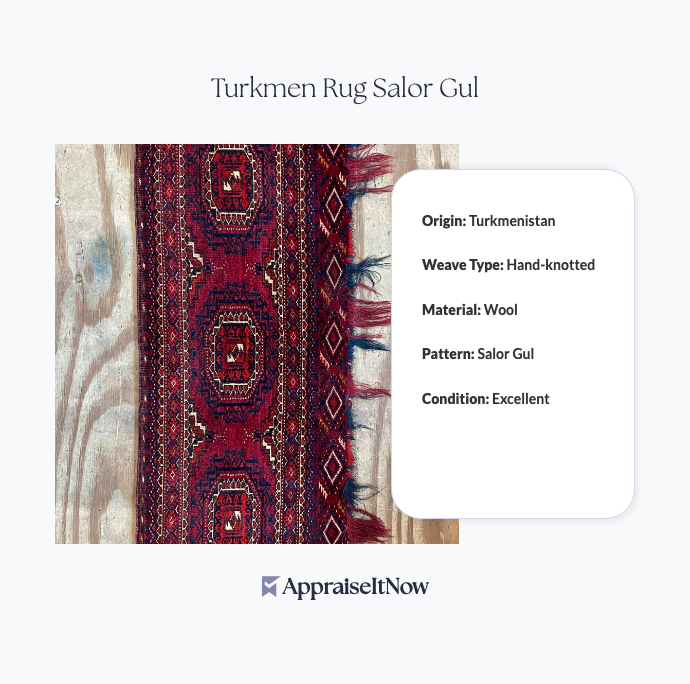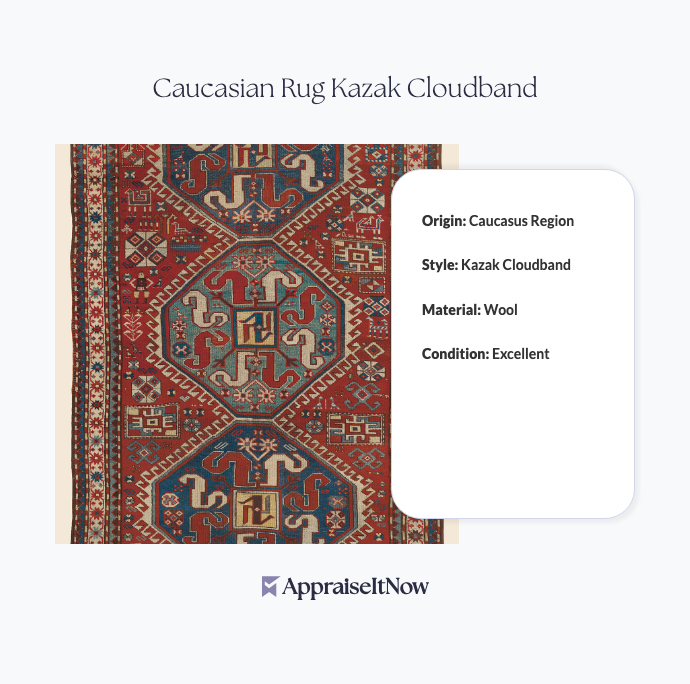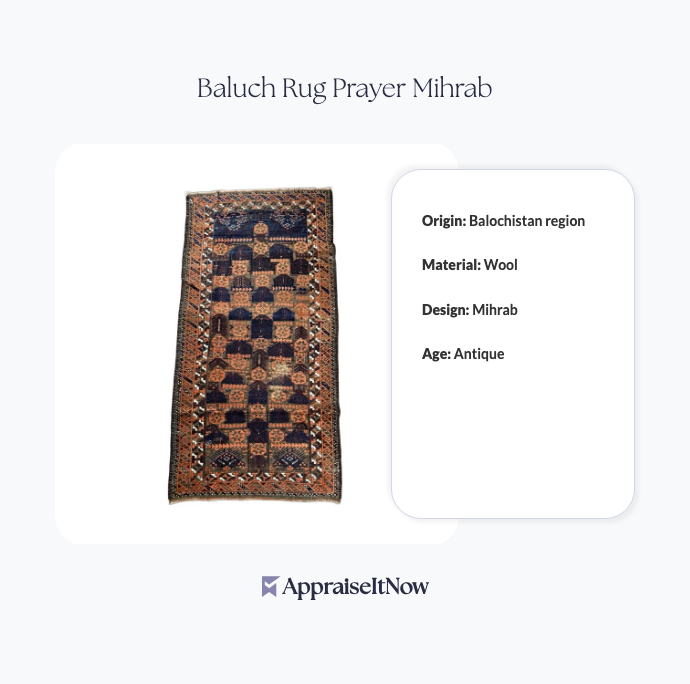<h1>How to Get Your Turkmen Rug Salor Gul Appraised</h1>
<p>If you own a Turkmen Rug Salor Gul, you're likely aware that this handwoven textile represents significant value and cultural heritage. Understanding the appraisal process for your rug—whether you're buying, selling, or establishing insurance coverage—helps you make informed decisions about this investment. Your Turkmen Rug Salor Gul, valued between <strong>$20,000 and $25,000</strong>, deserves proper professional evaluation to reflect its true market worth.</p>
<h2>Understanding What Makes Your Turkmen Rug Salor Gul Special</h2>
<p>The Turkmen Rug Salor Gul carries distinctive characteristics that collectors and appraisers recognize immediately. First introduced in the 19th century, these rugs feature the iconic <strong>Salor Gul</strong> pattern—a central diamond-shaped motif surrounded by smaller geometric diamonds arranged in perfect symmetry. What distinguishes your Turkmen rug is the combination of high-quality wool, natural pigment dyes, and the exceptional craftsmanship unique to Turkmen weavers. These elements aren't merely aesthetic; they directly influence your rug's appraisal value and collectibility.</p>
<p>The difference between a Turkmen rug and Turkish rug often causes confusion, but appraisers immediately recognize the distinction. Turkmen rugs originate from Central Asia and feature geometric tribal patterns, while Turkish rugs come from Turkey and typically showcase floral designs. The Salor Gul pattern specifically belongs to the Salor tribe of Turkmen weavers, making it distinct from Turkish weaving traditions. This geographic and cultural specificity adds to your rug's value when properly documented during appraisal.</p>
<div class="callout tip"><p><strong>Appraisal Advantage</strong></p>
<p>Professional appraisers trained in tribal textiles can identify your specific rug's origin, age, and authenticity—factors directly impacting its $20,000–$25,000 valuation.</p></div>
<h2>Why Professional Appraisal Matters for Textile Treasures</h2>
<p>You might wonder how to determine the value of a rug or how much should a Turkish rug cost. These questions don't have simple answers because rug valuation depends on multiple interconnected factors that require expert analysis. When you seek professional appraisal services through platforms like AppraiseItNow, you're gaining access to credentialed experts specializing in <a href="/blog/appraisals-for-fine-carpets-and-rugs-valuing-artistry-beneath-your-feet">fine carpets and rugs</a> who understand precisely what collectors look for in quality Turkmen pieces.</p>
<p>Professional appraisers examine the intricate details that casual observers miss. They assess the quality of your wool, test the permanence of your natural dyes, measure knot density, and verify the rug's age through construction techniques and wear patterns. This expertise becomes essential when establishing insurance coverage or preparing documentation for sale, charitable donation, or estate purposes. Do Turkish rugs increase in value? Yes—and Turkmen rugs follow similar market trends when properly authenticated and documented through professional appraisal.</p>
<h2>Key Factors Your Appraiser Will Evaluate</h2>
<p>When a qualified appraiser examines your Turkmen Rug Salor Gul, they'll assess these critical value drivers. Your rug's size directly impacts valuation; larger pieces command premium prices per square foot because they required more skilled labor and raw materials. The knot density—measured in knots per square inch—indicates both the weaver's skill and the rug's durability. Your appraiser will also examine the condition of your dyes, checking whether colors remain vibrant or have faded from sun exposure, as this significantly affects market appeal.</p>
<p>The specificity of your Salor Gul pattern matters too. Authentic tribal patterns feature slight, natural variations that distinguish handwoven rugs from machine-made imitations. Appraisers use magnification tools and comparative analysis to verify that your rug displays the hallmarks of genuine Turkmen craftsmanship. Your rug's provenance—where it came from, who owned it previously—adds historical context that seasoned collectors value. Documentation supporting these details becomes invaluable when appraising <a href="/blog/appraising-tribal-rugs-and-textiles-exploring-artistic-traditions-and-techniques">tribal rugs and textiles</a> for sale or insurance purposes.</p>
<h2>How to Identify a Quality Turkmen Rug Before Appraisal</h2>
<p>Understanding what distinguishes a good Turkish rug or Turkmen rug helps you recognize quality before professional appraisal. Run your hand across the surface—genuine wool feels supple, never stiff or plasticky like synthetic fibers. Flip the rug over and examine the knots on the underside; tightly packed knots indicate skilled weaving and superior durability. Your Salor Gul pattern should display perfect symmetry, and the colors should remain vivid without appearing unnaturally uniform, which would suggest modern chemical dyes rather than natural pigments.</p>
<p>How to tell a good Turkish rug applies equally to Turkmen examples: look for consistent tension in the weave, examine the selvages (side edges) for reinforcement indicating hand finishing, and check whether the rug lies flat without buckling or waves. These physical characteristics form the foundation of your appraiser's assessment and directly correlate with the $20,000–$25,000 valuation range your authentic Turkmen Rug Salor Gul commands in today's market.</p>
<div class="callout note"><p><strong>Inspection Insight</strong></p>
<p>Before scheduling professional appraisal, photograph your rug's front and back in natural light. Document any visible labels, manufacturer marks, or previous appraisal documentation you possess.</p></div>
<h2>When You Need Professional Appraisal</h2>
<p>You should obtain professional appraisal for your Turkmen Rug Salor Gul in several specific situations. If you're selling, an appraisal establishes a defensible asking price and provides documentation that serious buyers expect. For insurance purposes, a certified appraisal ensures you maintain adequate coverage reflecting your rug's current replacement cost. When making charitable donations, a professional valuation supports your tax deduction claims and satisfies documentation requirements from organizations like <a href="/blog/personal-property-appraisals-for-charitable-donations-maximizing-tax-benefits-through-accurate-valuations">personal property appraisals for charitable donations</a>.</p>
<p>Estate planning also benefits from professional appraisal; executors and beneficiaries need accurate valuations to properly distribute assets and pay estate taxes. If you've inherited a Turkmen rug and question its authenticity or condition, appraisal provides expert verification. Whether you're asking how to price a rug or how to get a rug appraised, the answer consistently points to professional evaluation by credentialed experts who understand <a href="/blog/appraising-fine-textiles-valuing-antique-fabrics-and-weavings">appraising fine textiles</a> and vintage textiles.</p>
<h2>Gathering Documentation for Your Appraisal</h2>
<p>Before scheduling your appraisal appointment, compile any documentation supporting your Turkmen Rug Salor Gul's history and provenance. Previous appraisals, bills of sale, and photographs showing the rug in earlier conditions provide valuable historical context. If your rug came with any authentication certificates or ethnic/cultural information, include these materials. Did you know how different is Turkmen from Turkish? Having documentation that clearly establishes your rug's Turkmen origin significantly strengthens your appraisal by confirming tribal weaving traditions rather than contemporary Turkish production.</p>
<p>Additionally, gather photographs showing different angles and lighting conditions, close-ups of the Salor Gul pattern details, and images of the underside revealing knot structure. If your rug bears any labels, markings, or numbers, photograph these clearly. You should also note when and where you acquired the rug, any previous owners if known, and any restoration or cleaning work performed. This documentation transforms a simple appraisal into a comprehensive record that supports your rug's valuation and facilitates future sales or insurance claims.</p>
<h2>Understanding Age and Vintage Characteristics</h2>
<p>How to tell if a rug is vintage involves examining construction techniques, wear patterns, and historical documentation. Genuine vintage Turkmen rugs display natural wear in high-traffic areas, with slight color variation from age and exposure. Your appraiser will inspect whether your Salor Gul pattern shows the expected patina rather than appearing artificially aged. Can you tell how old a Turkish rug is through professional analysis? Yes—skilled appraisers use construction methods, dye chemistry, and design evolution to estimate your rug's approximate age, often pinpointing decades or even specific production periods.</p>
<p>First-generation Salor Gul rugs from the 19th century command premium prices compared to later examples, as they represent earlier tribal weaving traditions before external market influences. Your appraiser will use this historical knowledge to position your specific rug within the $20,000–$25,000 range based on age and authenticity markers.</p>
<h2>Marketplace Context and Value Dynamics</h2>
<p>The question "Where can I sell a Turkish rug?" applies equally to Turkmen rugs and reveals important valuation context. Online marketplaces, auction houses specializing in <a href="/blog/appraising-antiques-unveiling-the-hidden-treasures-in-your-collection">antiques</a>, and direct sales to collectors represent common channels. However, the venues where you sell significantly impact pricing. Auction houses specializing in textiles and tribal art attract serious collectors willing to pay premium prices for authenticated pieces, whereas generalist online platforms may attract casual buyers offering below-market values.</p>
<p>Professional appraisers understand these market dynamics and provide pricing that reflects fair market value across all legitimate sales channels. This expertise ensures your appraised value accurately reflects what collectors would realistically pay today.</p>
<div class="callout tip"><p><strong>Market Advantage</strong></p>
<p>Rugs with comprehensive professional appraisals sell more quickly and at higher prices because buyers gain confidence from third-party expert documentation.</p></div>
<h2>The Appraisal Documentation You'll Receive</h2>
<p>When you work with AppraiseItNow's credentialed appraisers, you receive detailed documentation that serves multiple purposes. Your appraisal report includes high-quality photographs of your Turkmen Rug Salor Gul, comprehensive descriptions of its physical characteristics, assessment of its condition, and the appraiser's professional valuation. The report explains the methodology used to reach the $20,000–$25,000 value estimate, references comparable recent sales, and documents any unique characteristics or provenance details.</p>
<p>USPAP-compliant appraisal reports from credentialed professionals carry weight with insurance companies, courts, financial institutions, and auction houses. Unlike casual online valuations or dealer estimates, certified appraisals provide defensible documentation if your value determination is ever questioned. This professional documentation becomes particularly valuable for insurance claims where the insurer needs verification before authorizing replacement or settlement.</p>
<h2>Building Your Personal Property Portfolio</h2>
<p>As you compile professional appraisals for your Turkmen rugs and other <a href="/types/personal-property">personal property</a>, you're establishing a valuable portfolio documenting your collection's worth. This comprehensive inventory serves multiple purposes: it protects you in insurance disputes, facilitates estate planning, supports charitable donation documentation, and enables informed decisions about acquisition and sale. Many collectors find that regular updates to their appraisals—typically every 3-5 years for significant pieces—maintain accurate valuations reflecting market fluctuations.</p>
<p>Your Turkmen Rug Salor Gul appraisal becomes part of a larger documentation system that professionals can reference when evaluating your other <a href="/types/artwork">artwork</a>, <a href="/types/antique-furniture">antique furniture</a>, or <a href="/types/memorabilia-and-collectibles">memorabilia and collectibles</a>.</p>
<h2>Making Your Appraisal Investment Count</h2>
<p>Professional appraisal for your Turkmen Rug Salor Gul represents an investment that pays dividends across multiple aspects of ownership. The modest cost of appraisal services—typically a fraction of your rug's value—protects your financial interests through accurate insurance coverage, strengthens your position in sales negotiations, and provides expert authentication. Whether you're responding to the question "how much does it cost to get a Turkish rug cleaned?" or managing the full scope of your textile collection, professional documentation creates the foundation for informed decisions.</p>
<p>How to identify an expensive rug connects directly to professional expertise. Your certified appraiser brings years of experience comparing high-value textiles, recognizing subtle quality markers that distinguish premium pieces from good quality alternatives. This specialized knowledge ensures your Turkmen rug receives accurate valuation rather than relying on generalist estimates that often undervalue specialized collections.</p>
<div class="callout note"><p><strong>Key Takeaway</strong></p>
<p>Professional appraisal of your Turkmen Rug Salor Gul transforms this beautiful textile from a treasured possession into a documented asset with verified market value. Through certified experts at AppraiseItNow, you gain the authentication, documentation, and valuation necessary for insurance protection, confident sales decisions, and legacy preservation of this remarkable piece of Turkmen cultural heritage.</p></div>







.avif)







